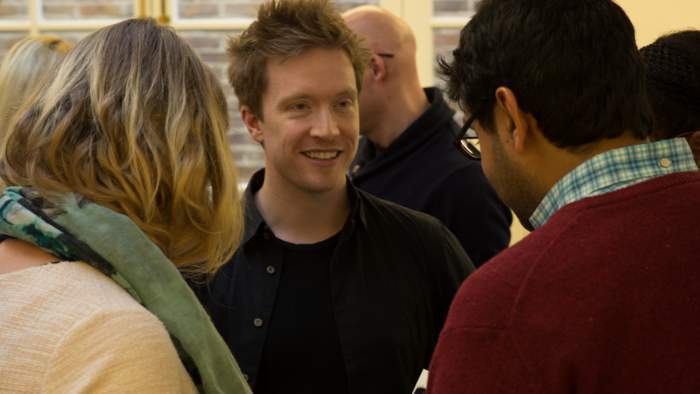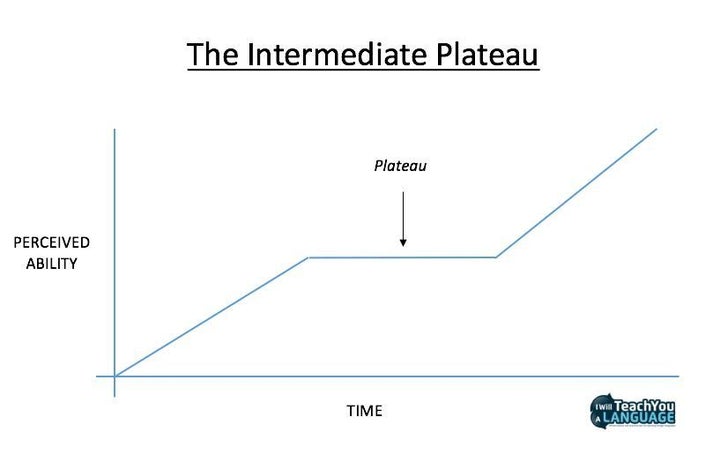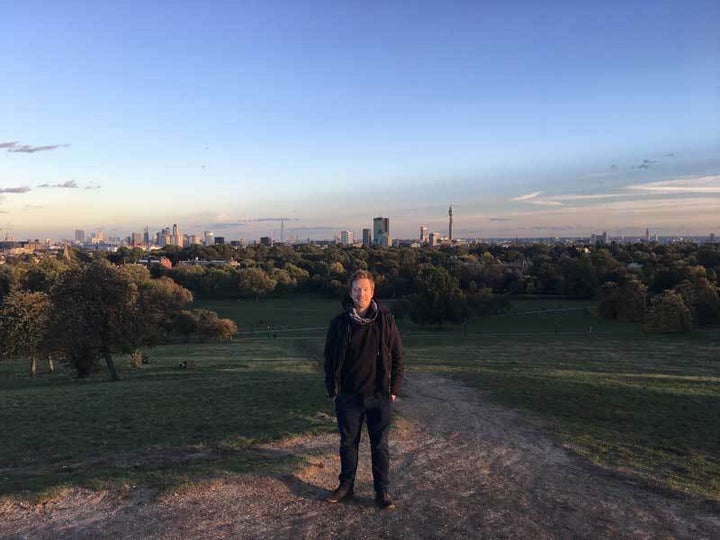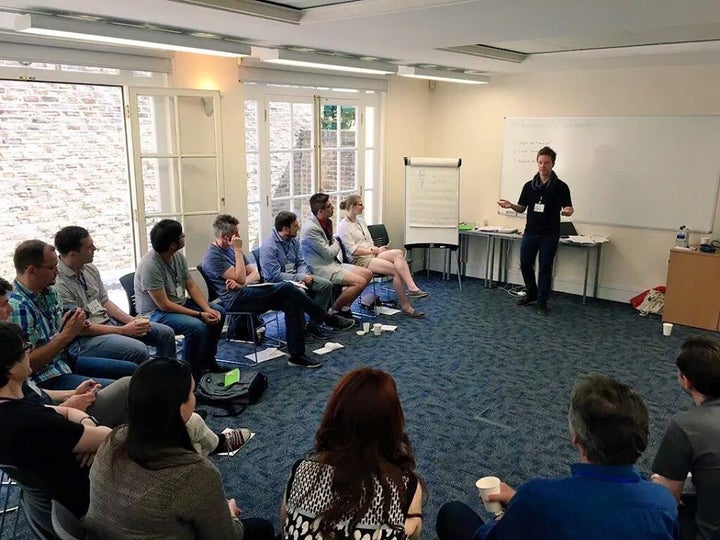
Olly Richards on the Spanish intermediate plateau
Do you remember your first few weeks learning Spanish?
It was lots of fun, right?
You'd learn some new words, a few useful expressions, and you'd be able to use them in simple conversations right away!
It was an amazing feeling... "At this rate, I'll speak fluent Spanish in no time!"
Except it didn't quite work out like that.
Somewhere along the line, your progress slowed...
Learning Spanish stopped being fun, and feelings of frustration started to creep in. You think: “Maybe I'm just not cut out to learn Spanish!”
Well, if you can relate to any of this, there's something important I want you to know:
It's completely normal!
Here’s why...
You're Stuck At The "Intermediate Plateau"
After learning eight languages myself, and teaching many thousands of people the secrets to foreign language acquisition...
I've noticed a phenomenon that reliably occurs to everyone after learning a language for some time.
It's called the "Intermediate Plateau" - and you're stuck there right now.

The intermediate plateau in Spanish
As you can see in the diagram above, the plateau is a phenomenon that occurs around an intermediate level, and is best described as giving you the feeling of making little or no progress for an extended period of time.
The main danger of finding yourself in this plateau, is that you become frustrated and begin to have feelings such as...
- I'm frustrated by my lack of expression in Spanish
- I'm losing my motivation to keep learning
- I've started to have pipe dreams of learning other languages instead
- I have begun to doubt whether I'm capable of ever speaking Spanish fluently
And if these feelings linger for long enough, you can lose your motivation to study, and even give up.
But wait!
There's hope...
The Plateau Is An Illusion!
In reality, the intermediate plateau is mostly an illusion. (That's why the Y-axis is labelled "perceived level".)
Why?
Well, when you learn Spanish as a beginner, virtually everything you learn in your textbook is immediately useful:
- Verbs like venir, comer, estar, pensar
- Nouns like comida, mesa, vida
- Adjectives like bueno, caliente, interesante
You can use them all in conversation right away, which gives you that wonderful feeling of satisfaction I mentioned earlier.
Now, fast-forward to the intermediate level, where you've already learned the basics, can conjugate your verbs, and can hold a conversation in Spanish.
From this point on, every new Spanish word or grammar point you learn is less and less useful to daily conversation:
- Verbs like porfiar (to insist) or aclarar (to clarify)
- Nouns like aliento (breath) or ramo (branch)
- Adjectives like asado (roasted) or cuadrado (square)
All very interesting words, but not likely to come up in your next conversation.
And this is why it's an illusion...
You're still learning... it just doesn't feel like it!
Now you know the plateau is an illusion, you should feel encouraged! Your mind is not "broken" after all!
So, with that said, how do you break through the intermediate plateau, and take your rightful place as a fluent Spanish speaker?
Let me show you how...

Learning to speak fluent Spanish means looking at the ”whole” picture
Learning Spanish At Intermediate Level
When you were a beginner, your Spanish study probably looked a bit like this:
- Learn something new in your textbook
- Practise using it in conversation
It's a classic behaviourist approach to language learning, and it works for beginners because the amount of new information is limited and controlled.
For example:
- yo soy inglés
- tú eres americano
- él es español
- etc...
This kind of exercise is a typical way of practising new information you’ve just learned in class.
However, in order to break through the intermediate plateau, you need to leave the safety and security of your textbook.
In order to break through the intermediate plateau in Spanish, you need to leave the safety and security of your textbook.
You need to expose yourself to real Spanish - the entirety of the Spanish language, in all its glory!
Becoming Fluent In Spanish With The “Whole Language”
Instead of learning individual "nuggets" of Spanish in your textbook, and practising those, you now have to study in an entirely different way, using what's known as the "whole language".
Studying with the "whole language" means spending time with real Spanish, as it is found out in the real world - real material, that hasn’t been filtered or contrived for learners:
- Books
- Radio
- Conversation
- Movies, etc
Using real Spanish as the basis for your study is a big task, but also an exciting one!
It’s this material that becomes the object of your study - not your textbook. You need to spend time with real language, notice how it is used, and then study that.
You learn a new word, because you need it to understand a book you’re reading. You learn a particular expression, because it comes up in the podcast you’re listening to. You finally understand a grammar point you’ve been struggling with for years, because it makes perfect sense in the context of a conversation you’re having with someone.
Notice how different this is from textbook study:
- Beginners: Study a "grammar nugget" as it's presented in your textbook, and try to use that in real life
- Intermediate: Spend time with real Spanish, and study how that is used
With textbooks, you put an artificial cap on what you can learn.
When you're spending all your time with real Spanish, you encounter far more words and phrases that you otherwise would, and you unlock the possibility of unlimited learning.
Everything you listen to or read becomes a potential source of learning.
Even if you're not studying something directly, the mere fact you're exposed to it means you can begin to learn passively.
But how exactly do you study real Spanish effectively?
Won’t you get overwhelmed?
Let's talk about how to do it.

Delivering a language workshop in London
Spanish "Whole Language" Study Tips
You’re going to need to spend a lot of time with Spanish.
It can’t be a “twice a week” affair.
So there are are two parts to this:
- Discover the best way to learn Spanish on your own, so you take make the most of your study time
- Make Spanish part of your lifestyle, so you have opportunities to learn passively
Part 1: Studying On Your Own
While you might not be able to speak Spanish every day, you can certainly study every day, so self-study is going to be your quickest path through the intermediate plateau and to fluency.
Now, you already know you need to study the “whole language”, but what’s the best way to do this?
Over my 15 years of language learning, I have experimented with many different methods and techniques. However, there is one approach above all that consistently stuns me with its effectiveness.
What is that technique?
Very simply, listening to audio while simultaneously reading the transcript.
The material itself can be, for example:
- a podcast with accompanying transcript
- a book with accompanying audiobook
- a textbook with recordings of dialogues
- a radio play or movie with the original script
The important thing is that you can listen and read at the same time, and that the material is of interest to you, so it’s motivating.
By having the text available as you listen, it allows you to pause the recording, go back and analyse what you hear, which strengthens your listening skills.
By being able to listen as you read, it places the words more firmly in your head, and increases the likelihood you will remember them later.
And by spending so much quality, in-depth time with Spanish, you will find your ability to speak also increases at the same time, as if by magic.
My recommendation:
- Choose audio tracks that are 3-5 minutes long, ideally on topics of interests to you
- The audio should be accompanied by a word-for-word transcript
- You should be able to understand at least 90% of the text already, otherwise it is too hard
This is the study sequence I use:
- Begin with the audio alone (no transcript), and listen many times over, trying to understand as much as you can;
- When you reach the limit of what you can understand, add the transcript. Continue to listen over and over, reading along with the transcript;
- As you listen, mark unknown words, so you can find them later;
- Look up the unknown words in a dictionary. You should now be able to understand most of the text, but don’t worry if there are some bits you’re unsure about.
- Hide the text, and go back to listening to the audio alone, over and over.
Repeat this process with the same material over a few days.
As your brain naturally forgets things from one day to the next, it’s by repeatedly coming back to the same material that you learn and absorb it.
When you start to feel confident with the audio you’re studying, you can move on to something new.
If you struggle to find good material to study with, you should consider the Fluent Spanish Academy, which is an extensive library of study material designed specifically for intermediate Spanish learners.
Part 2: A Spanish Lifestyle
If you’re going to become fluent in Spanish, you need to make the language a living, breathing part of your life.
As long as Spanish only exists on the page, you will never learn to use it naturally, the way you really want.
The process described above is extremely effective, but if you want everything you learn to translate into spoken fluency, you need to put it into practice.
Here are some brief ideas for making this happen:
- Spend more of your lesson time chatting freely about things that interest you - rather than a program of textbook or grammar-based lessons
- Go out and spend time with Spanish speakers (in language exchanges or cultural events) - rather than studying at home
- Take general-interest classes (salsa, life drawing, judo) conducted in Spanish, and make friends in the process - without waiting “till you’re ready”
- Read Spanish books, magazines, or blogs, in order to enjoy them - rather than as an object of study
- Read the news in Spanish - rather than your usual English-language channel
Conclusion
Breaking through the intermediate plateau in Spanish takes time and dedication, but by following the steps in this article, you do something extremely important... make it fun, and relevant to you!
That’s the best way to avoid stagnation, and motivate yourself to keep at it long enough to be successful.
I’ve shown you how you can orientate your study around things (materials and activities) that interest you, and study the “whole language” in order to unlock the full potential of your learning.
The best way to learn Spanish is not to wait until the day you’re fluent, and then begin to use it.
The secret to becoming fluent in Spanish is to embrace it as a lifestyle, and to enjoy it every day.
That’s how I did it, and I hope you will too!
